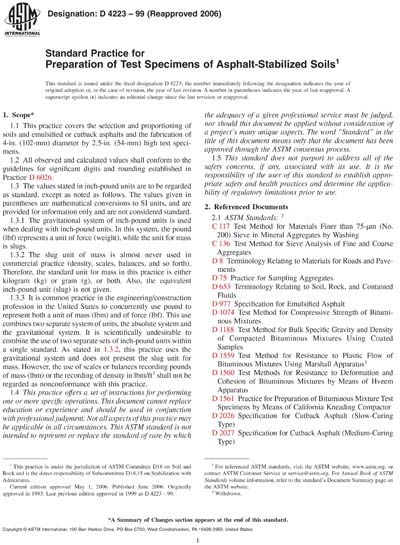Historical
ASTM D4223-99(2006)
Standard Practice for Preparation of Test Specimens of Asphalt-Stabilized Soils
1.1 This practice covers the selection and proportioning of soils and emulsified or cutback asphalts and the fabrication of 4-in. (102-mm) diameter by 2.5-in. (54-mm) high test specimens.
1.2 All observed and calculated values shall conform to the guidelines for significant digits and rounding established in Practice D 6026.
1.3 The values stated in inch-pound units are to be regarded as standard, except as noted as follows. The values given in parentheses are mathematical conversions to SI units, and are provided for information only and are not considered standard.
1.3.1 The gravitational system of inch-pound units is used when dealing with inch-pound units. In this system, the pound (lbf) represents a unit of force (weight), while the unit for mass is slugs.
1.3.2 The slug unit of mass is almost never used in commercial practice (density, scales, balances, and so forth). Therefore, the standard unit for mass in this practice is either kilogram (kg) or gram (g), or both. Also, the equivalent inch-pound unit (slug) is not given.
1.3.3 It is common practice in the engineering/construction profession in the United States to concurrently use pound to represent both a unit of mass (lbm) and of force (lbf). This use combines two separate system of units, the absolute system and the gravitational system. It is scientifically undesirable to combine the use of two separate sets of inch-pound units within a single standard. As stated in , this practice uses the gravitational system and does not present the slug unit for mass. However, the use of scales or balances recording pounds of mass (lbm) or the recording of density in lbm/ft3 shall not be regarded as nonconformance with this practice.
1.4 This practice offers a set of instructions for performing one or more specific operations. This document cannot replace education or experience and should be used in conjunction with professional judgment. Not all aspects of this practice may be applicable in all circumstances. This ASTM standard is not intended to represent or replace the standard of care by which the adequacy of a given professional service must be judged, nor should this document be applied without consideration of a project's many unique aspects. The word "Standard" in the title of this document means only that the document has been approved through the ASTM consensus process.This standard does not purport to address all of the safety concerns, if any, associated with its use. It is the responsibility of the user of this standard to establish appropriate safety and health practices and determine the applicability of regulatory limitations prior to use.
Content Provider
ASTM International [astm]






